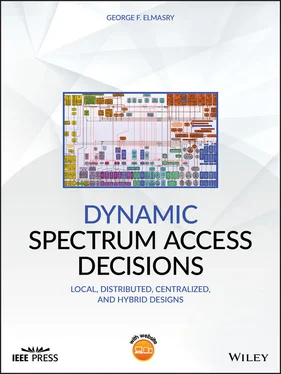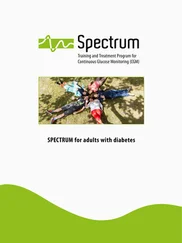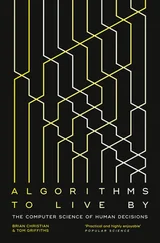8 8 Chapter 8 explains how co‐site interference avoidance can be another DSA cloud service.
Chapter 6 Dynamic Spectrum Management for Cellular 5G Systems
Part 1 of this book presented the foundations of creating a hybrid DSA design while relying on examples of heterogeneous hierarchical MANETs that demonstrate the most critical aspects of DSA design needs. Chapter 5 showed how to design DSA as a set of cloud services with metrics to measure spectrum use optimization objectively. This chapter covers the use of DSA 1with 5G cellular networks. There are commonalities and differences between hybrid DSA design for military cognitive MANET systems and DSA design for commercial cellular systems. With military MANET systems, all nodes in the network may be peers and all nodes may be mobile; there can be fast moving nodes such as fighter jets and slow‐moving nodes such as tanks and much slower nodes such as dismounted soldiers. A deployment of heterogeneous networks can be provisioned spectrum blocks for use in a nonopportunistic way. Waveforms forming networks may switch to opportunistic spectrum use in some cases but for the majority of the cases, networks use provisioned spectrum dynamically. These networks may share the provisioned spectrum blocks for an entire deployment dynamically before attempting to resort to the use of unlicensed bands. The problem domains in 5G cellular systems and military MANET systems are different, but they share many of the basic DSA concepts such as relying on spatial and time based sensing, collecting a knowledge repository, fusing the knowledge repository to produce decisions, performing interference mitigation techniques, and utilizing metrics to quantify the performance of dynamic spectrum use. As Chapter 5 showed, DSA can be developed as a set of cloud services in a hierarchical manner regardless of the system under consideration.
There are differences in the way DSA concepts are applied in military communications and in commercial use. With commercial cellular 5G, there are standardization bodies, research and development findings from industry and academia, and a mix of licensed and unlicensed spectrum use. There is a wide range of spectrum bands considered for use with 5G, including:
long‐term evolution (LTE) enhancements to utilize the spectrum below 6 GHz; this band increases capacity to about 2.5 times of that of LTE
segments of the 6–24 GHz band
the millimeter wave (mm‐wave) band between 24 and 86 GHz, which may bring the 20 Gbps theoretical speed to reality 2
bands above 86 GHz and up to 102.2 GHz for future considerations.
Notice that different countries have different ranges of spectrum allotted for the first trials of 5G. Table 6.1gives an example of different spectrum allocations for below 6 GHz in different areas of the world. This trend of using different bands at different areas of the world is expected for all 5G bands as spectrum licensing agents such as the US FCC has plans for spectrum use for civil applications that are different from those of other countries.
Table 6.15G frequency bands allotted below the 6 GHz range.
| Country |
Range (GHz) |
| Europe |
3.4–3.8 |
| China |
3.3–3.6 4.4–4.5 4.8–4.99 |
| USA |
3.1–3.55 3.7–4.2 |
| Japan |
3.6–4.2 |
| Korea |
3.4–3.7 |
This chapter will reference below 6 GHz access as “lower frequency” access (LTE or enhanced LTE). Lower frequency access plays an important role in 5G deployment and 5G DSM.
Opportunistic spectrum use at the cell level is a core part of 5G dynamic spectrum management while points of presence of LTE are still part of 5G. Notice that 5G standardizations call for cells to be deployed dynamically, making dynamic spectrum access more challenging because mobility is not limited to the end user only. 5G will also operate in a wide range of frequencies, including the mm‐wave range, which comes with its own challenges in designing advanced receiver techniques. 5G gives access to as much licensed spectrum as possible in addition to as much opportunistic use spectrum as possible, making it an umbrella for many commercial wireless capabilities outside of cellular technology. The mix of licensed spectrum and unlicensed spectrum makes the 5G dynamic spectrum management problem space as challenging as that of military communications systems, which do not have the concept of a fixed tower and all nodes are mobile.
There are different types of 5G cells, as shown in Table 6.2, where each size has an intended deployment. The ranges depicted in Table 6.2can be increased with better antenna technologies and are included in this table to help explain the concept of spatial modeling with dense deployment of 5G access points detailed later in this chapter. Notice that the number of users (end users) varies as it is dependent on many factors, such as proximity to the access point (which can decide the chip code), requested data rate, and propagation models. Notice also that 5G makes use of fiber cable ground infrastructure for connectivity of 5G points of presence (cells and towers) to the core network but also relies on using existing infrastructure such as LTE access points to achieve complete wireless coverage in areas where fiber infrastructure is not abundant.
Table 6.25G cell types.
| Cell type |
Intended commercial deployment |
Number of users |
Power (W) |
Range |
| Femto |
Residential and enterprise |
4–8 |
0.2–1 |
Few tens of meters |
| Pico |
Public areas (airports, malls, etc.) |
64–128 |
1–5 |
Tens of meters |
| Macro |
Urban |
128–256 |
5–10 |
Few 100s of meters |
| Metro |
Urban for additional coverage |
>256 |
10–20 |
100s of meters |
This chapter focuses on some of the 5G spectrum management techniques that are presented in research communities and standardization bodies. Note that 5G standardization gives a great deal of flexibility in dynamic spectrum management to the implementer, making the problem space of this area convoluted as there are different approaches to dynamic spectrum management and how it addresses challenges such as traffic allocation, network density, interoperability between the heterogeneous networks, and the use of orthogonal and nonorthogonal waveforms. The approach adopted in this chapter is to cover many DSM aspects without particularly diving into the details of building the cognitive algorithms that needs to be deployed in a service provider's network.
This section focuses on basic concepts for 5G that are needed to understand DSM. The reader is encouraged to refer to 5G references for more details. 5G can be conceptualized through the possible deployment scenarios of the 5G cells. Let us consider the following three possible deployments:
1 Standalone mm‐wave access. This deployment scenario is illustrated in Figure 6.1. One can think of dense urban deployments for this scenario where a high‐rise building would have most apartments using 5G cells connected to the core network through fiber links. This deployment scenario offers multiple access points to the end user and 5G calls for opportunistic serving of the end user where the cell that can offer the best service can be elected to serve the end user and hand over between cells can happen frequently.Opportunistic serving of an end user relies on DSM approaches. For example, the signal strength indicator from the different reachable cells can be used to decide which cell can be selected by the end‐user device as the access point. Other factors, such as the availability of services (a cell may have no more resources to allocate to a new end user), are also considered. Handover between cells also relies on signal strength and the calculation of self‐interference (SI) to decide which cell to switch to. This chapter elaborates more on how an end‐user device arbitrates between different access points.
Читать дальше












